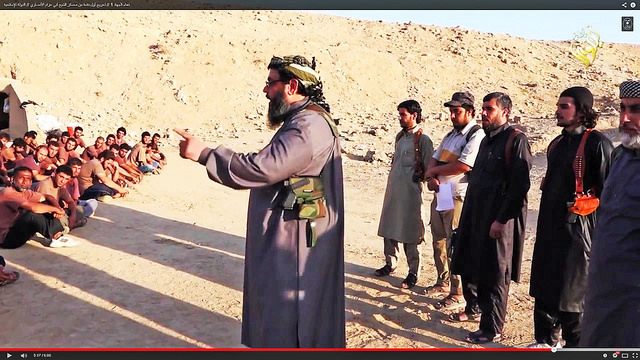by Derek Davison
A report recently issued by the Wilson Center suggests that the Islamic State (ISIS or IS) is fundamentally incapable of sustaining its early successes. On the other hand, al-Qaeda, which many believe has been eclipsed by IS, may still be the greater long-term terrorist threat to US and Western interests. The report, titled The Islamic State as Icarus: A Critical Assessment of an Untenable Threat and written by National Defense University scholar Thomas F. Lynch III, was released on October 5.
Lynch’s argument is rooted in an analysis of the many challenges IS faces. Although its high-profile split with al-Qaeda, its self-designation as a “caliphate,” and its rapid and dramatic successes in Iraq and Syria in 2014 brought IS a considerable amount of attention around the world, 2015 has not been as generous to the organization. In fact, despite isolated successes in Iraq (capturing the city of Ramadi) and Syria (capturing the Tadmur/Palmyra area), overall the group lost almost 10% of the territory previously under its control during the first half of this year.
Seven Reasons for Skepticism
Lynch’s report identifies seven factors that have caused the group’s progress to slow and that should create skepticism about its ability to compete with al-Qaeda over the long term:
- “Major Pushback from Multiple Foreign Militaries”: IS’s sudden successes may ultimately prove counterproductive, as the group is now opposed by no fewer than 64 separate nations involved in the U.S.-led anti-IS coalition, plus Iran and now Russia, and that doesn’t include irregular forces arrayed against it, like Kurdish militias in Syria and Shi?a militias in Iraq. As Lynch writes: “No major Salafi-Jihadist outfit—not AQ and not the Afghan Taliban after the 9/11 terror strikes in the United States—has previously inspired such a comprehensive set of encircling state adversaries in such a short time.”
- “The Dubious Quality of, and Limited Responses from, Appeals to Potential Affiliates”: One of the areas in which IS has been trying to compete with al-Qaeda is in the recruitment of regional affiliates outside of its core Syria-Iraq zone, similar to the Afghanistan-based al-Qaeda’s affiliate organizations in Syria (Jabhat al-Nusra) and Yemen (al-Qaeda in the Arabian Peninsula). So far, however, IS’s successes in this effort, while impressive numerically, have been limited to isolated groups, like the Islamic Movement of Uzbekistan in Central Asia, and to groups that have proven too parochial and/or too brutal even for al-Qaeda, like Nigeria’s infamous Boko Haram. Some of these affiliates have facilitated the flow of new fighters into Iraq and Syria, but there’s little evidence to show that IS has been able to expand its own power into the territories in which its affiliates operate.
- “Self-Defeating Foreign Fighter Recruitment Efforts”: IS has been very successful in recruiting foreign fighters to come to Iraq and Syria to join its cause. According to some estimates, 20,000 or more foreign recruits have joined the group since 2013. However, Lynch suggests that this recruitment may begin to backfire on IS. For one thing, there is growing evidence that foreign IS recruits are becoming disillusioned with the organization, either because they’re unhappy with their living conditions or repulsed by IS’s indiscriminate violence directed at other Muslims. As the pool of defectors grows and their stories become public, potential new recruits may begin to think twice about joining IS. For another thing, those foreign fighters have evidently clashed with local Sunni tribes, which (if it becomes a pattern) could make it far more difficult for IS to hang on to the predominantly Sunni areas it now controls.
- “Precarious Finances”: This may be the most counter-intuitive point on Lynch’s list, given that the Islamic State is thought to be extremely wealthy. However, IS acquired nearly half of its estimated $2 billion in assets in the capture of Mosul in June 2014 and its subsequent looting of the banks there. It sustains itself by relying on taxing the populations under its control, illicit fossil fuel sales, and kidnapping foreign nationals for ransom, but each of these is vulnerable to degradation. Coalition airstrikes have targeted IS’s energy production infrastructure, coalition member states have agreed to stop paying ransom for their kidnapped nationals, and the organization’s tax revenues are only as substantial as the territory it controls. IS has also been unable to tap into one of the most reliable jihadi funding streams, charitable contributions from wealthy Gulf patrons, due to the next item on Lynch’s list.
- “[IS’s status as] a Jihadist Pariah”: The Islamic State’s break with al-Qaeda and its indiscriminate violence has cut it off from much of the rest of the Salafi-Jihadist community, including the wealthy Gulf patrons whose charitable contributions continue to fund al-Qaeda and related groups. Consequently, Gulf charitable funding is being directed toward groups that are explicitly fighting against IS in Syria.
- “Risky Social Media Messaging”: IS has made copious use of social media to spread its propaganda, broadcast its successes, recruit new followers, and encourage sympathetic individuals to carry out terrorist attacks. Lynch argues that employing social media to such a degree comes at a cost: it allows intelligence and law enforcement agencies to gain insights into IS’s activities and organization, and it limits the organization’s appeal by widely broadcasting its brutality to the general public.
- “An Ambitious and Unforgiving Territorial Timeline”: As Lynch writes, “by its own logic, the IS caliphate must grow robustly across the Middle East and the wider Islamic world to fulfill its promise. However, it has actually stopped growing in Iraq and Syria, and its claims of group affiliate attacks have yet to produce demonstrable territory gains elsewhere.” If IS can’t start gaining territory again, Lynch writes, its current supporters may well turn against it.
At an October 15 Wilson Center event to roll out his report, Lynch suggested that Islamic State leader Abu Bakr al-Baghdadi’s decision in summer 2014 to “form and frame an international Islamic caliphate within five years,” a break with al-Qaeda’s vision of a caliphate to be formed at some unspecified future time, may prove to be a mistake. Lynch said, “That is an enormous amount of pressure put on that organization to pull together and show territorial gains” as well create “quality” affiliates, in that five year period. This pressure, according to Lynch’s research, forces IS to claim responsibility for acts to which they are only tenuously connected at best. As more is learned about IS’s actual ability (or lack thereof) to project its authority outside of its Iraq/Syria birthplace, Lynch argues that the group’s “messaging of inexorable gain” will begin to come apart. Lynch later suggested that IS could begin to come apart in “as short a timeline as two and a half to three years” if “the very impatient people that actually populate ISIS” begin to see that the group is not making sustainable gains outside of its core territory.
Limited Appeal
In his report, Lynch cites the case of South Asia, where al-Qaeda and IS have been directly competing for dominance in what he calls the “Salafi-Jihadist space.” Al-Qaeda’s decision last September to form its own South Asian affiliate, al-Qaeda in the Indian Subcontinent, was intended to lock IS out of the Afghanistan-Pakistan-India -Bangladesh-Myanmar region, and for the most part it seems to have succeeded. IS has struggled to gain a foothold there, and its recruitment of fighters from that region has lagged considerably behind its recruitment of fighters from elsewhere, even Europe. The South Asian example may show the limits of IS’s appeal and suggests that al-Qaeda will continue to compete with the younger organization for affiliates and recruits moving forward.
Analyst Daveed Gartenstein-Ross of the Foundation for Defense of Democracies told the Wilson Center audience that al-Qaeda remains a greater threat to Western interests than the Islamic State despite the fact that IS has the higher profile at the moment. He pointed out that IS’s brutality, so heavily emphasized in its own public propaganda, drastically limits its pool of potential recruits to people who agree that IS’s most extreme practices, like genocide and sexual slavery, are good things. That, Gartenstein-Ross noted, is “a high bar.” On the other hand, al-Qaeda has quietly been using IS’s extremism to recast itself in a more moderate and potentially more broadly appealing light in places like Syria and Yemen, which earns it more public support and potentially more backing from those wealthy Gulf financiers.
Harleen Gambhir, a counterterrorism analyst at the Institute for the Study of War, cautioned that the Islamic State hasn’t stopped trying to expand beyond Iraq/Syria and has in particular established footholds in Libya, Egypt, and Afghanistan. It’s using these regional affiliates, which admittedly “are not necessarily the strongest or most powerful groups within each of these areas,” to “help set the conditions for expansion” by increasing “disorder…so that they can set conditions for ISIS’s eventual expansion.” The existence of these affiliates, however dubious their strength or reach, also allows IS to at least claim to be competing with al-Qaeda all around the world.
It’s questionable the extent to which al-Qaeda still poses a major threat to the United States at this point. As Lynch said in his October 15 remarks, losses incurred in the decade between September 11 and the killing of Osama bin Laden by U.S. Special Forces in 2011 have left al-Qaeda “no longer the global catastrophic terror threat that it had been on the precipice of 9/11 or even the several years beyond that.” The group hasn’t successfully carried out a terrorist attack inside the United States since 2001 (though it presumably still wants to do so). In 2013, The Washington Post noted that terrorist attacks overall in the United States had been steadily declining for several decades. But given the alarm that the Islamic State’s quick rise to power generated within the circles of power in Washington, something that actually helps IS by feeding into propaganda about its “inexorable gain,” Lynch’s report represents an important countervailing viewpoint.
Image: from a video of the graduation from an Islamic State training camp





